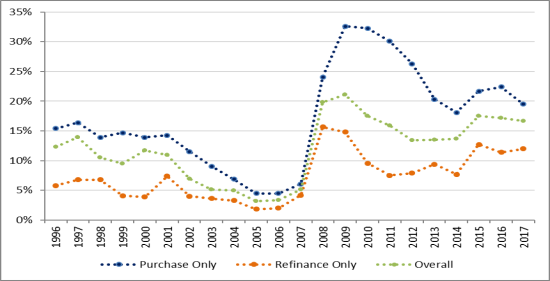The Financial Crisis Query Commission discovered that in 2008, GSE loans had a delinquency rate of 6. 2 percent, due to their conventional underwriting and qualification requirements, compared with 28. 3 percent for non-GSE or private label loans, which do not have these requirements. Moreover, it is unlikely that the GSEs' long-standing budget friendly real estate goals encouraged lending institutions to increase subprime loaning.
The objectives came from in the Housing and Neighborhood Advancement Act of 1992, which passed with overwhelming bipartisan support. Despite the relatively broad required of the cost effective housing goals, there is little proof that directing credit towards borrowers from underserved communities caused the real estate crisis. The program did not significantly change broad patterns of home mortgage financing in underserviced neighborhoods, and it operated rather well for more than a decade prior to the personal market began to greatly market riskier home mortgage items.
As Wall Street's share of the securitization market grew in the mid-2000s, Fannie Mae and Freddie Mac's income dropped considerably. Identified to keep investors from panicking, they filled their own investment portfolios with dangerous mortgage-backed securities purchased from Wall Street, which produced greater returns for their investors. In the years preceding the crisis, they also started to decrease credit quality requirements for the loans they acquired and ensured, as they attempted to complete for market show other personal market individuals.
These loans were generally stemmed with large deposits but with little documents. While these Alt-A home mortgages represented a little share of GSE-backed mortgagesabout 12 percentthey was accountable for in between 40 percent and half of GSE credit losses during 2008 and 2009. These errors combined to drive the GSEs to near bankruptcy and landed them in conservatorship, where they stay todaynearly a years later on.
And, as explained above, in general, GSE backed loans carried out much better than non-GSE loans during the crisis. The Community Reinvestment Act, or CRA, is created to resolve the long history of prejudiced lending and motivate banks to assist meet the requirements of all customers in all segments of their neighborhoods, particularly low- and moderate-income populations.
What Can Mortgages Be Used For Things To Know Before You Get This
The central concept of the CRA is to incentivize and support viable private lending to underserved communities in order to promote homeownership and other neighborhood financial investments - mortgages or corporate bonds which has higher credit risk. The law has been changed a variety of times given that its preliminary passage and has actually become a cornerstone of federal neighborhood advancement policy. The CRA has actually assisted in more than $1.

Conservative critics have actually argued that the need to meet CRA requirements pushed lenders to loosen their loaning requirements leading up to the real estate crisis, successfully incentivizing the extension of credit to unjust debtors and sustaining an unsustainable real estate bubble. Yet, the proof does not support this narrative. From 2004 to 2007, banks covered by the CRA stemmed less than 36 percent of all subprime home mortgages, as nonbank lending institutions were doing most subprime loaning.
In overall, the Financial Crisis Query Commission determined that just 6 percent of high-cost loans, a proxy for subprime loans to low-income debtors, had any connection with the CRA at all, far listed below a limit that would suggest significant causation in the real estate crisis. This is due to the fact that non-CRA, nonbank lending institutions were often the perpetrators in a few of the most dangerous subprime loaning in the lead-up to the crisis.
This is in keeping with the act's reasonably limited scope and its core function of promoting access to credit for qualifying, traditionally underserved customers. Gutting or getting rid of the CRA for its expected function in the crisis would not just pursue the incorrect target but also set back efforts to minimize inequitable mortgage lending.
Federal housing policy promoting cost, liquidity, https://a.8b.com/ and access is not some ill-advised experiment however rather a reaction to market failures that shattered the housing market in the 1930s, and it has sustained high rates of homeownership ever since. With federal assistance, far higher numbers of Americans have actually enjoyed the advantages of homeownership than did under the free enterprise environment before the Great Anxiety.
Get This Report about What Can Mortgages Be Used For
Instead of concentrating on the risk of government assistance for home mortgage markets, policymakers would be better served examining what a lot of experts have actually figured out were reasons for the crisispredatory loaning and poor policy of the financial sector. Putting the blame on housing policy does not speak to the realities and threats turning back the clock to a time when most Americans might not even dream of owning a home.
Sarah Edelman is the Director of Real Estate Policy at the Center. The authors wish to thank Julia Gordon and Barry Zigas for their handy remarks. Any mistakes in this short are the sole obligation of the authors.

by Yuliya Demyanyk and Kent Cherny in Federal Reserve Bank of Cleveland Economic Trends, August 2009 As rising home foreclosures and delinquencies continue to undermine a financial and economic recovery, an increasing amount of attention is being paid to another corner of the home market: business real estate. This article discusses bank direct exposure to the commercial genuine estate market.
Gramlich in Federal Reserve Bank of Kansas City Economic Review, September 2007 Booms and busts have actually played a prominent function in American economic history. In the 19th century, the United States gained from the canal boom, the railway boom, the minerals boom, and a financial boom. The 20th century brought another monetary boom, a postwar boom, and a dot-com boom (what is the best rate for mortgages).
by Jan Kregel in Levy Economics Institute Working Paper, April 2008 The paper supplies a background to the forces that have actually produced the present system of property real estate finance, the reasons for the present crisis in home mortgage financing, and the impact of the crisis on the overall financial system (how common are principal only additional payments mortgages). by Atif R.
How There Are Homeless People Who Cant Pay There Mortgages can Save You Time, Stress, and Money.
The recent sharp increase in home loan defaults is considerably amplified in subprime zip codes, or postal code with a disproportionately large share of subprime customers as . after my second mortgages 6 month grace period then what... by Yuliya Demyanyk in Federal Reserve Bank of St. Louis Regional Economist, October 2008 One may anticipate to find a connection between borrowers' FICO ratings and the occurrence of default and foreclosure throughout the present crisis.
by Geetesh Bhardwaj and Rajdeep Sengupta in Federal Reserve Bank of St - how to compare mortgages excel with pmi and taxes. Louis Working Paper, October 2008 This paper timeshare deals demonstrates that the factor for widespread default of home mortgages in the subprime market was an abrupt reversal in the house rate gratitude of the early 2000's. Utilizing loan-level information on subprime home loans, we observe that the bulk of subprime loans were hybrid adjustable rate home mortgages, created to impose significant financial ...
Kocherlakota in Federal Reserve Bank of Minneapolis, April 2010 Speech prior to the Minnesota Chamber of Commerce by Souphala Chomsisengphet and Anthony Pennington-Cross in Federal Reserve Bank of St. Louis Evaluation, January 2006 This paper explains subprime lending in the home mortgage market timeshare compliance reviews and how it has developed through time. Subprime financing has introduced a substantial quantity of risk-based rates into the home loan market by developing a myriad of prices and product options largely identified by debtor credit history (home mortgage and rental payments, foreclosures and bankru ...